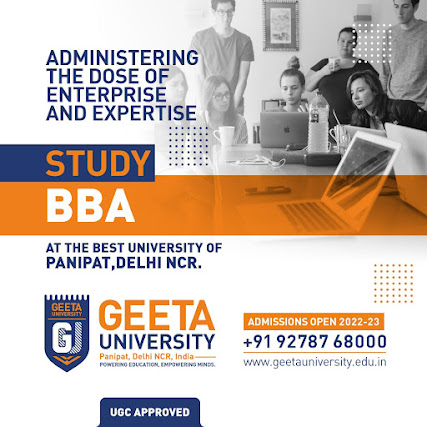The Best BBA University in Haryana encompasses introductory and advanced courses in the following areas:
Course formats include lectures with discussion sections, seminars, and studios, offering a range of learning experiences emphasizing individual and group work, project-driven learning and special workshops, as well as field-based research. In Senior Seminar and Thesis classes, students research and analyze both economic and cultural aspects of the marketing and management of designed objects, environments, and experiences.
Old approach:
Earlier we used to teach concept after concept, ending the unit with a project encouraging students to apply everything they’d learned. By the time students got to the actual project they’d often forgotten what was taught in the first lesson.
New approach:
To actively engage students from the start, we now lead with the project. All concepts are taught within the context of that project and students learn as they build. Learning occurs when students can make connections between real experiences (projects) and concepts. Our new approach creates this ideal learning environment. Project-driven learning also resulted in a few unexpected benefits that we’re excited about:
1) It allows students of different skill levels to engage with our course material
2) It encourages a proper workflow, more effectively teaching concepts like version control and debugging
3) Students gain the confidence to ask the right questions on Google and Stack Overflow when they get stuck
Best BBA University in Haryana emphasizes project-based learning by learning activities that are long-term, interdisciplinary and student-centered. Project-based instruction differs from traditional inquiry by its emphasis on students' collaborative or individual artifact construction to represent what is being learned. Project-based learning also gives students the opportunity to explore problems and challenges that have real-world applications, increasing the possibility of long-term retention of skills and concepts. When students use technology as a tool to communicate with others, they take on an active role vs. a passive role of transmitting the information by a teacher, a book, or broadcast. The student is constantly making choices on how to obtain, display, or manipulate information.
Technology makes it possible for students to think actively about the choices they make and execute. Every student has the opportunity to get involved either individually or as a group.
- Strategic Thinking and Management in Design and Business
- Innovation and Sustainability Research
- Quantitative Thinking
- Data Analysis and Financial Management
- Critical Reasoning through Reading and Writing
- Visual Communication and Information Design
- Scenario Planning and Entrepreneurship and Leadership
Course formats include lectures with discussion sections, seminars, and studios, offering a range of learning experiences emphasizing individual and group work, project-driven learning and special workshops, as well as field-based research. In Senior Seminar and Thesis classes, students research and analyze both economic and cultural aspects of the marketing and management of designed objects, environments, and experiences.
Old approach:
Earlier we used to teach concept after concept, ending the unit with a project encouraging students to apply everything they’d learned. By the time students got to the actual project they’d often forgotten what was taught in the first lesson.
New approach:
To actively engage students from the start, we now lead with the project. All concepts are taught within the context of that project and students learn as they build. Learning occurs when students can make connections between real experiences (projects) and concepts. Our new approach creates this ideal learning environment. Project-driven learning also resulted in a few unexpected benefits that we’re excited about:
1) It allows students of different skill levels to engage with our course material
2) It encourages a proper workflow, more effectively teaching concepts like version control and debugging
3) Students gain the confidence to ask the right questions on Google and Stack Overflow when they get stuck
Best BBA University in Haryana emphasizes project-based learning by learning activities that are long-term, interdisciplinary and student-centered. Project-based instruction differs from traditional inquiry by its emphasis on students' collaborative or individual artifact construction to represent what is being learned. Project-based learning also gives students the opportunity to explore problems and challenges that have real-world applications, increasing the possibility of long-term retention of skills and concepts. When students use technology as a tool to communicate with others, they take on an active role vs. a passive role of transmitting the information by a teacher, a book, or broadcast. The student is constantly making choices on how to obtain, display, or manipulate information.
Technology makes it possible for students to think actively about the choices they make and execute. Every student has the opportunity to get involved either individually or as a group.

No comments:
Post a Comment